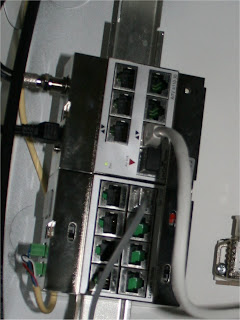Just to refresh your memory, we are installing the distribution cabinet inside an otherwise unused bulkhead in the house.
 ^ The distribution cabinet with the face panel now in place. You can see the white wire at the bottom left - that's the power supply lead to the panel which needs to be lengthened and then run through one of the punch out holes in the cabinet.
^ The distribution cabinet with the face panel now in place. You can see the white wire at the bottom left - that's the power supply lead to the panel which needs to be lengthened and then run through one of the punch out holes in the cabinet. ^ Looking up from the bottom towards the top of the panel, you can see I've put in a shelf. The LexCom room outlet wires are neatly bundled together. The extra cream cable is the telephone cable - it just needs to be gathered and tied for neatness.
^ Looking up from the bottom towards the top of the panel, you can see I've put in a shelf. The LexCom room outlet wires are neatly bundled together. The extra cream cable is the telephone cable - it just needs to be gathered and tied for neatness. ^ Here's the shelf - it has our ADSL modem/router/Wireless point. The ADSL input comes from the LexCom box, and there are two blue cables out - one goes directly to LexCom data switch in the cabinet, and the other goes direct to one of the room outlets.
^ Here's the shelf - it has our ADSL modem/router/Wireless point. The ADSL input comes from the LexCom box, and there are two blue cables out - one goes directly to LexCom data switch in the cabinet, and the other goes direct to one of the room outlets. ^ Here you can see blue cable that goes directly to one of the room outlets. The two grey patch leads are for TV antenna, and the blue patch cable links the data switch to a room outlet.
^ Here you can see blue cable that goes directly to one of the room outlets. The two grey patch leads are for TV antenna, and the blue patch cable links the data switch to a room outlet. ^ This is the mess you are left with after terminating 24 room outlet cables.....
^ This is the mess you are left with after terminating 24 room outlet cables.....















































